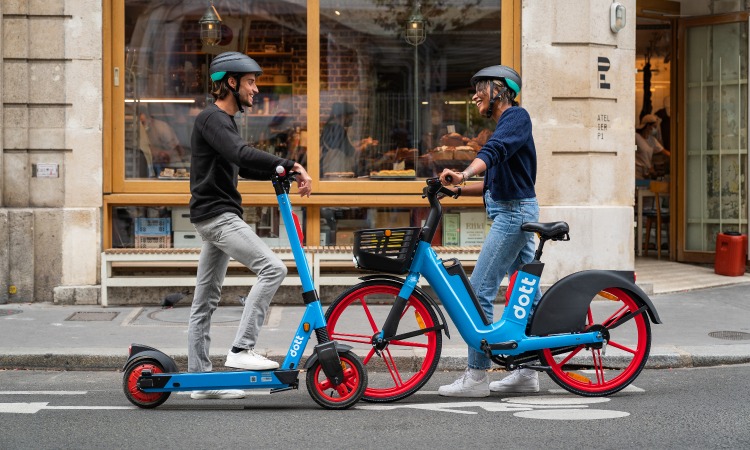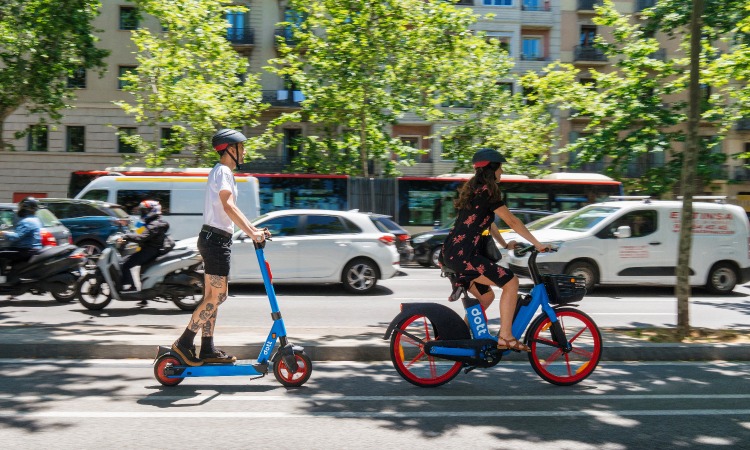Accelerating active travel with e-scooters and e-bikes
- Like
- Digg
- Del
- Tumblr
- VKontakte
- Buffer
- Love This
- Odnoklassniki
- Meneame
- Blogger
- Amazon
- Yahoo Mail
- Gmail
- AOL
- Newsvine
- HackerNews
- Evernote
- MySpace
- Mail.ru
- Viadeo
- Line
- Comments
- Yummly
- SMS
- Viber
- Telegram
- Subscribe
- Skype
- Facebook Messenger
- Kakao
- LiveJournal
- Yammer
- Edgar
- Fintel
- Mix
- Instapaper
- Copy Link
Posted: 16 January 2023 | Duncan Robertson - Dott | No comments yet
Following the announcement from Active Travel England that new funding is being made available to improve walking and cycling infrastructure in the UK, Duncan Robertson, General Manager for UK & Ireland at Dott, shares his thoughts on how shared electric vehicles contribute to increased general active travel by attracting people who might not otherwise use traditional push bikes and by reducing the barriers created through individual scooter/bike ownership.


Credit: Dott - Carless future visualisation of London, including sustainable Dott. View of Bank of England Royal Exchange and City Skyline.
Cities across the globe are rightly focusing on increasing active travel. We have seen car use being restricted in city centres, cycle lanes built in huge numbers and incentives like the UK’s long established ‘Cycle to Work’ scheme, which lowers costs to bike ownership. The announcement at the start of 2023 from Active Travel England to invest nearly £33 million to help make places more walkable and cyclable is a welcome development to further support the shift from our reliance on cars to more sustainable alternatives.
The concept of ‘active travel’ can still be alienating to many people. It implies a certain level of fitness, access to what is often expensive equipment… All of this can be intimidating to people who are new to any kind of active travel, and leads people to stick to their habits and rely on polluting forms of transport”
But the concept of ‘active travel’ can still be alienating to many people. It implies a certain level of fitness, access to what is often expensive equipment and conjures up an image of the stereotypical ‘middle aged man in lycra’ (or MAMIL) cyclist. All of this can be intimidating to people who are new to any kind of active travel, and leads people to stick to their habits and rely on polluting forms of transport.
The benefits of cycling and walking are obvious, with health and fitness benefits for the users, whilst taking cars off the roads and supporting cleaner air in our cities. But, do electric vehicles contribute to these same goals? We believe that they have an important role in bringing new audiences to active travel that might not otherwise walk or cycle. This can help us to move towards cities with cleaner air that are more pleasant to be in.
Whilst e-bike and e-scooter users may have started as mostly young and male, this is evolving as our service matures. We now have a more equal gender balance, with the share of women riders increasing by 48% since 2020, as well as seeing more users from older age groups.
This more diverse audience shows that more people are discovering how shared e-vehicles can be beneficial for different occasions. This follows a typical technology adoption curve, with use shifting from experimental or leisure to regular, recurring and everyday. In 2022, the number of rides on our vehicles almost doubled (a total increase of 94%) and the peak time for use is now during the morning and evening commuter rush hours, with shared e-scooters and e-bikes becoming an everyday tool that people rely on regularly.
Low cost and well maintained
Personal ownership of any kind of bike or scooter can be expensive, as well as difficult to store in our crowded cities. It was reported in 2022 that wait times for bike storage can be up to four years1, with many people being forced to squeeze their bikes into hallways, or bedrooms, in the meantime.
Shared schemes such as Dott overcome these barriers, providing an affordable alternative, and with the benefit of regular maintenance handled by in-house experts. As well as planned maintenance, vehicle checks happen at every battery swap, around 1 in 10 rides, ensuring that shared vehicles are well maintained and reliable for users, who don’t need to worry about unexpected repair costs.


Credit: Dott
Improving health
Our own research from a recent rider survey shows that 41% of our users report using bikes (shared and private) more since they started to use Dott. This can be attributed to people becoming more comfortable on push bikes once they have experienced cycling in their city on an e-bike, having overcome a perceived safety concern.
And academic research2 also shows that, for those that continue to use e-bikes, the physical gains are actually similar to those experienced by cyclists, because e-bike riders take longer trips. When considering some of Europe’s major cities, such as London, where commuting distances can be significant, cycling for those lengths can be hugely off putting for a lot of people. The effortless ease of e-bikes resolves this, providing an efficient way to move across greater distances without breaking a sweat.
Comfortable
Shared fleets of e-scooters and e-bikes also offer better flexibility for those combining trips with public transport”
Our research shows that half (50%) of Dott riders use our vehicles to reach work or school. In these situations, people might not want to have to take a shower on arrival and prefer to arrive ready to start their day. E-scooters and e-bikes facilitate this and, in the summer, can be a cooler and less stressful way of arriving than on often overcrowded public transport.
Shared fleets of e-scooters and e-bikes also offer better flexibility for those combining trips with public transport. They remove the issue of having to return to a particular station for a parked bike, making it easier for those doing a single trip or planning to get home on a different route.
Fully encouraging active travel recognises that people have different needs at different times. Whilst cycling might be a preference to some people on some days and in certain circumstances, e-scooters and e-bikes can be for others depending on their needs. This should be considered when developing infrastructure.


Credit: Dott
Infrastructure considerations
A major hurdle for our riders continues to be road infrastructure, with 65% of our riders (and 74% of women riders) saying that improving it would make riding Dott feel safer. In our experience across Europe, some of the most successful safety measures include segregated cycle lanes, lowering speed limits for cars in city centres and car-free zones, which make vulnerable road users feel safer.
Some of the most successful safety measures include segregated cycle lanes, lowering speed limits for cars in city centres and car-free zones, which make vulnerable road users feel safer”
Beyond those, specific measures can increase e-scooter and e-bike use. Crucially, to increase use and to provide a high quality experience for users, is a consistent approach across a city, as well as reduced slow and no-go zones and a high density of parking spots. In combination, these steps can help to accelerate the modal shift to low carbon and healthy transport.
We are continuing to offer training sessions and e-learning tools for our riders to reinforce road safety, but combining this with improved conditions on our road could have a big impact in increasing use.
This new funding could have a significant role in this, and we urge policymakers to consider shared e-scooters and e-bikes when planning improvements to the UK’s roads. Recognising the needs of both conventional active travel methods and e-scooter and e-bike users can help to increase usage and make active travel the preferred choice for travel across our city centres.
References
- https://www.times-series.co.uk/news/20014218.london-cyclists-waiting-four-years-secure-bike-storage/?ref=rss
- https://www.sciencedirect.com/science/article/pii/S259019821930017X


Related topics
Accessibility, Active travel, Air Quality, Alternative Power, Fleet Management & Maintenance, Infrastructure & Urban Planning, Micro-mobility, Multimodality, Passenger Experience, Sustainable Urban Transport, Traffic Management, Transport Governance & Policy, Vehicle & Passenger Safety
Related modes
Bikes & Scooters
Related cities
London
Related countries
United Kingdom
Related organisations
Active Travel England, Dott
Related people
Duncan Robertson








